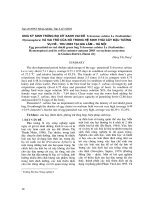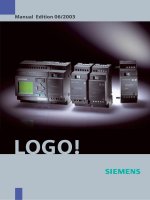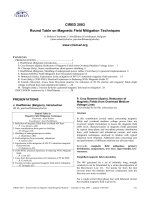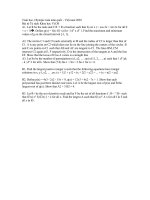C693 93(reapproved 2003)
Bạn đang xem bản rút gọn của tài liệu. Xem và tải ngay bản đầy đủ của tài liệu tại đây (28.96 KB, 3 trang )
Designation: C 693 – 93 (Reapproved 2003)
Standard Test Method for
Density of Glass by Buoyancy1
This standard is issued under the fixed designation C 693; the number immediately following the designation indicates the year of
original adoption or, in the case of revision, the year of last revision. A number in parentheses indicates the year of last reapproval. A
superscript epsilon (e) indicates an editorial change since the last revision or reapproval.
5.4 Nickel-Chromium-Iron or Platinum-Alloy Wire, less
than 0.2-mm diameter for suspending the specimen either in a
basket or a loop made of the same wire. The suspension wire
shall be cleaned by degreasing or heating in a vacuum.3 An
acceptable alternative method of cleaning the platinum-alloy
wire is to heat in an oxidizing gas flame until there is no longer
any color emitted from the gases passing around the wire.
5.5 Weights, with accuracy of 0.1 mg.
5.6 Barometer, with sensitivity of 1-mm Hg (optional, see
Note 3).
1. Scope
1.1 This test method covers the determination of the density
of glasses at or near 25°C, by buoyancy.
1.2 This standard does not purport to address all of the
safety concerns, if any, associated with its use. It is the
responsibility of the user of this standard to establish apppropriate safety and health practices and determine the applicability of regulatory limitations prior to use.
2. Referenced Documents
2.1 ASTM Standards:
E 12 Terminology Relating to Density and Specific Gravity
of Solids, Liquids, and Gases2
6. Reagent
6.1 Distilled Water, fresh, boiled, and used within 24 h,
allowed to stabilize at balance air temperature for at least 2 h
in the beaker.
3. Terminology
3.1 Definition:
3.1.1 density of solids—the mass of a unit volume of a
material at a specified temperature. The units shall be stated as
grams per cubic centimetre (see Terminology E 12).
7. Test Specimen
7.1 Specimens weighing about 20 g, with a minimum of
seeds or other inclusions (Note 1), shall be taken or cut from
the sample object, preferably in cylindrical or rectangular bar
form with smooth, slightly rounded surfaces having no cracks
or sharp edges.
4. Significance and Use
4.1 Density as a fundamental property of glass has basic
significance. It is useful in the physical description of the glass
and as essential data for research, development, engineering,
and production.
NOTE 1—For a specimen of 20 g with a density of approximately 2.5
g/cm3, a gaseous void of diameter 2 mm will cause an error in measured
density of 0.05 %.
7.2 The specimens shall be cleaned, handling them with
tweezers throughout subsequent operations, by immersion
preferably in an ultrasonic bath of hot nitric acid, chromicsulfuric acid, or organic degreasing solvent, followed by a
rinsing in alcohol and distilled water. For samples only soiled
by ordinary handling or exposure, adequate cleaning may be
obtained using a warm 2 % volume MICRO-brand4 detergent,
followed by a deionized or distilled water rinse.
5. Apparatus
5.1 Analytical Balance, with sensitivity and accuracy of 0.1
mg.
5.2 Beaker, of convenient capacity (250 to 750 cm3) to fit
inside the balance chamber and allow immersion of the basket
or wire loop specimen holder in distilled water.
5.3 Thermometers, calibrated (20 to 30°C), sensitive to
0.1°C for determining air and water temperatures.
1
This test method is under the jurisdiction of ASTM Committee C14 on Glass
and Glass Products and is the direct responsibility of Subcommittee C14.04 on
Physical and Mechanical Properties.
Current edition approved May 15, 1993. Published July 1993. Originally
approved in 1971. Last previous edition approved in 1988 as C 693 – 84 (1988)e1.
2
Discontinued—Replaced by E 1547, Annual Book of ASTM Standards, Vol
15.05.
3
Bowman, H. A., and Schoonover, R. M., “Procedure for High Precision Density
Determinations by Hydrostatic Weighing.” Journal of Research, National Bureau of
Standards, Vol 71C, No. 3, July–August 1967, pp. 179–198.
4
Manufactured by International Products Corporation, PO Box 70, Burlington,
NJ 08016.
Copyright © ASTM International, 100 Barr Harbor Drive, PO Box C700, West Conshohocken, PA 19428-2959, United States.
1
C 693 – 93 (2003)
8. Procedure
8.1 Hold the specimens and covered beaker of boiled
distilled water near the laboratory balance until the water has
cooled to ambient temperature before weighing.
8.2 Read the laboratory air temperature to the nearest 1°C.
Read the barometric pressure to the nearest 1-mm Hg. A fixed
laboratory average barometric pressure estimate is an acceptable alternative to the barometric pressure measurement (see
Note 3). Determine the density, rA, of the air from Table 1.
elevation, barometric pressure decreases by approximately 25-Hg. For
glass densities in the range of 2 to 6 g/cm3, a barometric pressure estimate
based on this relationship will result in density measurement bias of less
than 0.004 % under normal atmospheric pressure variations.
8.6 Weigh the glass and holder in the distilled water to the
nearest 0.1 mg and record as WT.
8.7 Remove the glass from the holder. At the reference
position, weigh the empty holder in the distilled water, to the
nearest 0.1 mg and record as WO.
TABLE 1 Density of Dry Air, g/cm3
Pressure, mm Hg
Temperature,
°C
720
730
740
750
760
770
20
21
22
23
24
25
26
27
28
29
30
0.001 141
137
134
130
126
122
118
115
111
107
104
0.001 157
153
149
145
142
138
134
130
126
123
119
0.001 173
169
165
161
157
153
149
146
142
138
134
0.001 189
185
181
177
173
169
165
161
157
153
150
0.001 205
201
197
193
189
185
181
177
173
169
165
0.001 221
216
212
208
204
200
196
192
188
184
180
8.3 Weigh the glass specimen in air to the nearest 0.1 mg
and record as WA.
8.4 Place the beaker of water with immersed thermometer
on a platform supporting it over the balance pan so that the pan
or balance arm is free to swing.
8.5 Place the specimen in the basket or loop holder and hang
this holder from the balance arm by means of a suitable hook
and the suspension wire. Immerse the basket and specimen by
raising the beaker of distilled water until the surface of the
water is at a predetermined reference position on the suspension wire.
8.8 Read the distilled water temperature to the nearest 0.1°C
and determine the water density from Table 2. Record this as
rW.
9. Calculation
9.1 Calculate the weight of the specimen in water, WW, as
follows:
WW 5 WT 2 W O
(1)
9.2 Calculate the glass density, r, at the average air-water
laboratory temperature, TL, as follows:
r5
NOTE 2—Before use, the beaker of water should be covered to
minimize dust. Just before the weighing of the basket and specimen, the
water surface near the suspension wire may be cleaned by a vacuum
nozzle or pipet technique. The suspended assembly should be agitated
slightly with a vertical motion to wet the suspension wire above the
meniscus at the reference position and to ensure that no air bubbles are
adhering to the glass or holder.
NOTE 3—A laboratory average barometric pressure estimate may be
determined from the elevation of the laboratory estimated to the nearest
170 m (500 ft). The national average barometric pressure corrected to sea
level (0 elevation) is 760-mm Hg. For each 341-m (1000-ft) increase in
~WArW 2 WWrA!
~ WA 2 WW !
(2)
9.3 Calculate the glass density, rS, at a standard reference
temperature, TS, as follows:
rS 5
r
1 1 3a~TS 2 TL!
(3)
where a is the approximate instantaneous coefficient of
linear thermal expansion at TS.
NOTE 4—For low expansion glasses or small temperature intervals or
TABLE 2 Density of Air-Free Water, g/cm3
Temperature,
°C
0.0
0.1
0.2
0.3
0.4
0.5
0.6
0.7
0.8
0.9
20
21
22
23
24
25
26
27
28
29
30
0.998 20
799
777
754
730
705
679
652
624
595
565
818
797
775
752
727
702
676
649
621
592
562
816
795
773
749
725
700
673
646
618
589
559
814
793
770
747
722
697
671
643
615
586
556
812
791
768
744
720
694
668
640
612
583
553
810
788
766
742
717
692
665
638
609
580
550
808
786
763
740
715
689
662
635
606
577
547
806
784
761
737
712
687
660
632
603
574
543
804
782
759
735
710
684
657
629
600
571
540
801
779
756
732
707
681
654
626
598
568
537
2
C 693 – 93 (2003)
11.1.1 With proper precautions taken to minimize dissolved
air in the water and adhering air bubbles during immersion of
the specimen and holder, this procedure will yield glass density
to a standard deviation within 60.1 %.
11.1.2 With precautions taken to minimize air-water temperature differences and to correct for temperature, etc., effects
on air and water density, this procedure will yield glass density
to a standard deviation close to 60.03 %.
11.2 Bias—Three glass density standard reference materials
are available from the Standard Reference Materials Program,
National Institute of Standards and Technology. Bias can be
experimentally assessed by measurement of density by this
procedure for these glasses.
both, this correction is not required.
10. Report
10.1 Report the following information:
10.1.1 Identification of test sample, production, manufacturer, glass type, and so forth as required,
10.1.2 Density of glass, r or rS, in grams per cubic
centimetre,
10.1.3 Temperature, TS or TL, for which glass density is
reported,
10.1.4 Thermal history of specimen. If unknown, it should
be so stated, and
10.1.5 Estimate of the volume of voids and inclusions.
11. Precision and Bias
11.1 Precision:
ASTM International takes no position respecting the validity of any patent rights asserted in connection with any item mentioned
in this standard. Users of this standard are expressly advised that determination of the validity of any such patent rights, and the risk
of infringement of such rights, are entirely their own responsibility.
This standard is subject to revision at any time by the responsible technical committee and must be reviewed every five years and
if not revised, either reapproved or withdrawn. Your comments are invited either for revision of this standard or for additional standards
and should be addressed to ASTM International Headquarters. Your comments will receive careful consideration at a meeting of the
responsible technical committee, which you may attend. If you feel that your comments have not received a fair hearing you should
make your views known to the ASTM Committee on Standards, at the address shown below.
This standard is copyrighted by ASTM International, 100 Barr Harbor Drive, PO Box C700, West Conshohocken, PA 19428-2959,
United States. Individual reprints (single or multiple copies) of this standard may be obtained by contacting ASTM at the above
address or at 610-832-9585 (phone), 610-832-9555 (fax), or (e-mail); or through the ASTM website
(www.astm.org).
3









